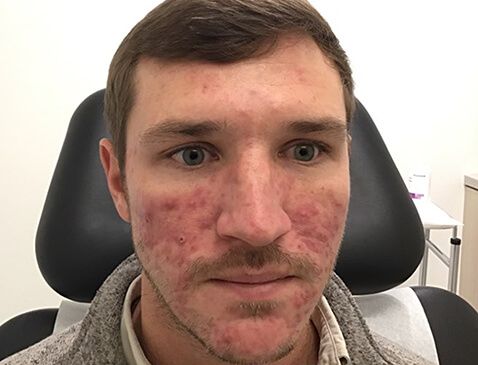

Acne Treatments
Acne is the term for plugged pores (blackheads and whiteheads), pimples, and even deeper lumps (cysts or nodules) that occur on the face, neck, chest, back, shoulders and upper arms. Acne affects most teenagers to some extent. However, the disease is not restricted to any age group. Adults in their 20s – even into their 40s – can get acne. While not a life threatening condition, acne can be upsetting and disfiguring. When severe, acne can lead to serious and permanent scarring. Even less severe cases can lead to scarring.
Before and After Acne Treatments
View Acne Treatments Photo Gallery
Types of Acne
Here is a brief summary of definitions of words used to describe acne from the American Academy of Dermatology:
- Comedone – A comedo is a sebaceous follicle plugged with sebum, dead cells from inside the sebaceous follicle, tiny hairs, and sometimes bacteria. When a comedo is open, it is commonly called a blackhead because the surface of the plug in the follicle has a blackish appearance. A closed comedo is commonly called a whitehead; its appearance is that of a skin-colored or slightly inflamed “bump” in the skin. The whitehead differs in color from the blackhead because the opening of the plugged sebaceous follicle to the skin’s surface is closed or very narrow, in contrast to the distended follicular opening of the blackhead. Neither blackheads nor whiteheads should be squeezed or picked open, unless extracted by a dermatologist under sterile conditions. Tissue injured by squeezing or picking can become infected by staphylococci, streptococci and other skin bacteria.
- Cyst – A cyst is a sac-like lesion containing liquid or semi-liquid material consisting of white blood cells, dead cells, and bacteria. It is larger than a pustule, may be severely inflamed, extends into deeper layers of the skin, may be very painful, and can result in scarring. Cysts and nodules often occur together in a severe form of acne called nodulocystic. Systemic therapy with isotretinoin is sometimes the only effective treatment for nodulocystic acne. Some acne investigators believe that true cysts rarely occur in acne, and that (1) the lesions called cysts are usually severely inflamed nodules, and (2) the term nodulocystic should be abandoned. Regardless of terminology, this is a severe form of acne that is often resistant to treatment and likely to leave scars after healing.
- Papule – A papule is defined as a small (5 millimeters or less), solid lesion slightly elevated above the surface of the skin. A group of very small papules and microcomedones may be almost invisible but have a “sandpaper” feel to the touch. A papule is caused by localized cellular reaction to the process of acne.
- Pustule – A dome-shaped, fragile lesion containing pus that typically consists of a mixture of white blood cells, dead skin cells, and bacteria. A pustule that forms over a sebaceous follicle usually has a hair in the center. Acne pustules that heal without progressing to cystic form usually leave no scars.
- Macule – A macule is the temporary red spot left by a healed acne lesion. It is flat, usually red or red-pink, with a well defined border. A macule may persist for days to weeks before disappearing. When a number of macules are present at one time they can contribute to the “inflamed face” appearance of acne.
- Nodule – Like a papule, a nodule is a solid, dome-shaped or irregularly-shaped lesion. Unlike a papule, a nodule is characterized by inflammation, extends into deeper layers of the skin and may cause tissue destruction that results in scarring. A nodule may be very painful. Nodular acne is a severe form of acne that may not respond to therapies other than isotretinoin.
Who gets acne?
Nearly everybody between the ages of twelve and seventeen have at least an occasional whitehead, blackhead or pimple, regardless of race or ethnicity. Many of these young people are able to manage their acne with over-the-counter (nonprescription) treatments. For some, however, acne is more serious. In fact, by their mid-teens, more than 40% of adolescents have acne severe enough to require some treatment by a physician.
In most cases, acne starts between the ages of ten and thirteen and usually lasts for five to ten years. It normally goes away on its own sometime in the early twenties. However, acne can persist into the late twenties or thirties or even beyond. Some people get acne for the first time as adults.
Acne affects young men and young women about equally, but there are differences. Young men are more likely than young women to have more severe, longer lasting forms of acne. Despite this fact, young men are less likely than young women to visit a dermatologist for their acne. In contrast, young women are more likely to have intermittent acne due to hormonal changes associated with their menstrual cycle and acne caused by cosmetics. These kinds of acne may afflict young women well into adulthood.
Acne lesions are most common on the face, but they can also occur on the neck, chest, back, shoulders, scalp, and upper arms and legs.
What treatment options are available for acne?
The appropriate treatment for acne depends on the severity. Options may include mild over-the-counter treatments, prescription medications such as isotretinoin (i.e., Accutane), light therapy treatments such as Accure or Blu-U, or laser treatments such as VBeam.
Isotretinoin
Isotretinoin (formerly referred to as Accutane) is prescription medication used to treat severe acne that is resistant to other forms of treatment. Accutane is a retinoid (derivative of Vitamin A) that works by shrinking oil producing glands in the skin. This effectively reduces the amount of sebum (oil) produced, minimizing the chances for pores to become clogged and acne to develop.
Isotretinoin is sold under numerous brand names including Absorica, Amnesteem, Claravis, Myorisan, and Sotret. Dosages of Isotretinoin can be tailored to the needs of each individual patient based on the severity of their acne. Most Isotretinoin treatment programs span 4-5 months. Pros and cons of beginning an Isotretinoin treatment plan should be discussed with your dermatologist.
How do laser acne treatments work?
Laser treatments safely and effectively treat acne with no downtime and minimal pain. Acne laser treatments target overactive sebaceous glands in your skin – the root cause of acne. Unlike some acne therapies that only address bacterial symptoms, acne laser treatments target the source of acne. The laser emits gentle pulses of energy that penetrate deep enough in the skin to shrink oil glands and decrease their capacity to produce acne without affecting the oils necessary for healthy skin. The laser causes your body to rebuild and replenish your own natural collagen leading to smoother and more evenly toned skin texture.
Laser and light based treatments can be used on any area of skin. During the procedure, most patients feel only a slight tingling sensation as the laser pulses. Patients with sensitive skin may use a topical anesthetic. Treatments takes only minutes to perform and you can resume normal activities immediately following treatment. For optimal results, most patients receive approximately four treatments. While every patient is different, a reduction in the number of acne lesions may be noticed shortly after the first treatment.
Now Offering Accure Acne Laser
Accure is a revolutionary laser therapy that effectively treats mild to severe facial acne. The treatment has been FDA approved to address mild to severe inflammatory acne vulgaris, the most common type of acne that includes whiteheads, blackheads, and inflamed or pus-filled bumps (“pimples”) with minimal side effects.
Additional Acne Resources
- Yes, Acne Scars Can Be Prevented. Here’s How:
- The Best Treatments For Each Type Of Acne Scar
- Ask A Dermatologist: Is Adult Acne on the Rise?
- Battling Buttne (Butt Pimples): Causes, Treatments, and Prevention
- How to Get Rid of a Pimple in 24 Hours: Fast Fixes for Clear Skin
- These Skin Bumps Are Not Pimples: Acne Mimicking Skin Conditions
- Boobne (Breast Acne): Causes, Treatments, and Prevention
- Fungal Acne: Symptoms, Prevention, And Treatment Options
- Considering Accutane? Here’s What You Should Know
- Hidradenitis Suppurativa (Acne Inversa): Causes, Symptoms, Prevention, and Treatments
- Dermatologist Answers: Can Makeup Cause Acne Breakouts?
- Treating Acne Scars with Punch Excision
- Ask A Dermatologist: The Link Between Diet and Acne
- Can Birth Control Pills Help with My Acne?
- Acne: When To See A Dermatologist
- The Best Ways to Prevent & Remove Blackheads
- Treating Acne Scars With Dermal Fillers
- Chest Acne: Causes, Prevention, and Treatment Options
- My Isotretinoin (Accutane) Journey
- 12 Daily Habits that are Making Your Acne Worse
- Preventing & Treating Maskne: Acne Caused By COVID-19 Mask Wearing
- Treating Hormonal Acne Without Birth Control
- Should You Pop That Pimple?
- Blackheads vs. Whiteheads: What’s the Difference?
- 6 Reasons to Not Pop that Pimple
- Acne: Everyday Things that May be Causing Your Breakouts
- Dermatologist Answers: Effective Acne Scar Treatments
- Does Drinking Milk Cause Acne?
- What Causes Acne Scars (And How To Get Rid Of Them)
- Back Acne: Causes, Prevention, and Treatment Options
- 6 Common Questions About Accutane
- Diagnosis Acne: What Kind of Acne Do I Have?
- Next Generation Acne Treatments
 Before
Before  After
After  Before
Before  After
After